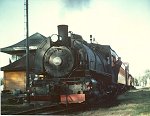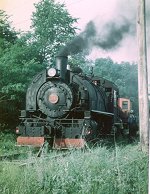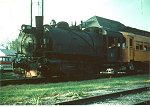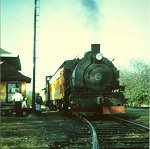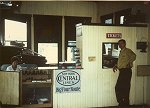Vernon, Greensburg and Rushville RR - Part 2
Note: More photos and drawings will be added as I get them scanned and uploaded.
Mike Hayes, stationed in Germany, asked some questions concerning the Michigan Division from Rushville to North Vernon. I answered these questions by e-mail and Mike suggested that I write an article for the web site, Railroads of Madison County. This is not a full history but an overview of the area at this time in history.
January 21, 2003
In part one, we established the setting of the VGR, Vernon Greensburg and Rushville Railroad located in central Indiana in 1880. Starting at Rushville at highway 44 the VGR ended, becoming the Lake Erie and Western. Cars were interchanged between the two railroads until 1891 when the Cincinnati Wabash and Michigan filled the 38 mile gap between Anderson and Rushville. At Rushville was a depot and freight house, turntable and associated buildings.
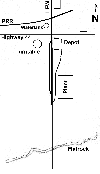 After 1891 extra trackage around the depot was reduced to #8 track on the west side of the main and used as a passing siding. On the east side, a track from the main to the east side of the depot to unload freight and the south end used as a team track, later extended farther south to accomodate a fertilizer plant. Sometime after 1892 new business on the north end of town caused the Big Four (CCC&StL) to build tracks to serve these industries and also a siding called Kern.
After 1891 extra trackage around the depot was reduced to #8 track on the west side of the main and used as a passing siding. On the east side, a track from the main to the east side of the depot to unload freight and the south end used as a team track, later extended farther south to accomodate a fertilizer plant. Sometime after 1892 new business on the north end of town caused the Big Four (CCC&StL) to build tracks to serve these industries and also a siding called Kern.
About a mile north of the VGR depot the LE&W and the Big Four divide. The LE&W going northeast and the Big Four northwest. From this point south to the VGR depot trains operated on the LE&W main looking out for each other. In later years, #78 northbound, did not get stopped at the PRR crossing and ran through the PRR train. Freight cars were damaged but little damage to the engine and no injuries.
 Moving south of Rushville 7.5 miles, we come to Milroy. As discussed in part one, Milroy was a stand alone town. The depot set at main street and the railroad. East of the depot was the elevator. The siding switch was about five car lengths north of the depot and held about 25 cars. At about a third of the way from the south end of the siding, coming from the siding, there were two tracks, one for the elevator and the other used as a house track and team track behind the depot.
Moving south of Rushville 7.5 miles, we come to Milroy. As discussed in part one, Milroy was a stand alone town. The depot set at main street and the railroad. East of the depot was the elevator. The siding switch was about five car lengths north of the depot and held about 25 cars. At about a third of the way from the south end of the siding, coming from the siding, there were two tracks, one for the elevator and the other used as a house track and team track behind the depot.
 In front of the depot was a switch leading to a fifteen car side track west of the main that serviced a canning factory on the south end and an unloading spot for a gasoline bulk plant on the north end. The north switch and about half of the track were removed in later years. Milroy was a daytime train order and block station. There were two
passenger trains each way after 1893.
In front of the depot was a switch leading to a fifteen car side track west of the main that serviced a canning factory on the south end and an unloading spot for a gasoline bulk plant on the north end. The north switch and about half of the track were removed in later years. Milroy was a daytime train order and block station. There were two
passenger trains each way after 1893.
This is the only place where you made a dutch drop at least once a week. A dutch drop is a means of getting a car in front of you, into a position behind you and does require that the track the car is being kicked into is slightly upgrade. Giving the car a kick into the track, a brakeman rides the car into the track to apply a brake if need be.
The other brakeman throws the switch, the engine runs by the switch on the other track, the switch is thrown, and the car is allowed to roll out of the track behind the engine. The engine is coupled to the car and the move is completed.
The meaning of the word drop, has changed in meaning as I have noticed in magazine articles so I will try to explain. You do not drop a car at a station or track. You set off a car or leave a car at a point. To drop a car is done in this manner. Say you must place a car in a stub track against a facing switch. You stop short of the switch about
150 feet and prepare the car. One brakeman will handle the switch and one will cut the car off and ride it into the clear. The signal is given, the engine and car start moving at a pace that will allow the car to roll in the clear. The brakeman gives the slack signal, slack is given, and the pin is pulled. The engine speeds away, and when it
is clear of the switch, the brakeman throws switch allowing car to roll into the other track. If the car needs to be spotted, the engine is brought into the track to spot the car. The meaning of dutch in the expression, dutch drop, is to pay or make your own way. This is fulfilled when the car comes from the track it was kicked into by its own.
In 1951 #71 and the northbound local had a headon in front of the depot with only one injury but two destroyed engines.
 Moving three miles south is Williamstown, a flag stop for four passenger trains. The next town 2.5 miles south is Sandusky.
Moving three miles south is Williamstown, a flag stop for four passenger trains. The next town 2.5 miles south is Sandusky.  The business here was an elevator, store, blacksmith, etc. Sandusky after 1900 had a depot but was not a block or train order station. There was a siding located here also. It was a regular stop for one passenger train each way and a flag stop for two others.
Sandusky was made a block station in later years, and because of a curvature of the track, when coming south on a train, you only had an instant to see the signal indication before it went out of sight behind the elevator. The crews were very alert at this point. The business here was an elevator, store, blacksmith, etc. Sandusky after 1900 had a depot but was not a block or train order station. There was a siding located here also. It was a regular stop for one passenger train each way and a flag stop for two others.
Sandusky was made a block station in later years, and because of a curvature of the track, when coming south on a train, you only had an instant to see the signal indication before it went out of sight behind the elevator. The crews were very alert at this point.
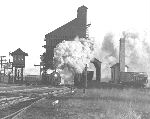 Another 5.8 miles was Greensburg. This was the intermediate terminal for the VGR, CI&StL, CH&G making it a busy place. There were 15 tracks in the yards plus other tracks for business locations around the town. With the coming of Avon yards and Penn Central and ConRail, Greensburg ceased to be a railroad center after about 130 years.
Another 5.8 miles was Greensburg. This was the intermediate terminal for the VGR, CI&StL, CH&G making it a busy place. There were 15 tracks in the yards plus other tracks for business locations around the town. With the coming of Avon yards and Penn Central and ConRail, Greensburg ceased to be a railroad center after about 130 years.
Moving 7 miles south, we come to Horace, a small village with a siding. Another 2 miles was the small town of Letts Corner. 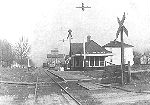 Letts at its height had a population of about 150 souls. The strange thing about Letts and the railroad was that the depot was a train order and block station but only a 10 car siding. This siding served the elevator and also served as a team track on the south end.
Letts at its height had a population of about 150 souls. The strange thing about Letts and the railroad was that the depot was a train order and block station but only a 10 car siding. This siding served the elevator and also served as a team track on the south end.
The four passenger trains stopped daily, the two southbounds #1 at 9:22am and #33 at 4:46pm. The northbounds #34 at 9:43am and #2 at 4:21pm. The depot closed after WW2.
Four miles south of Letts stands Westport the gem of the VGR and the early years of the Big Four. From the late 1800's until the 1920's, limestone and an interchange of coal and other products continued between the Southern Indiana (SI) and the Big Four. When the SI closed in 1961, there still was a small amount of interchange. In the early years Westport was a twenty four hour train order and block station, testifying to the amount of business. There was also a siding located here. To show the activity, in 1913 there were two freights Greensburg to Louisville and two in the opposite direction that ran daily. The following historical account of Westport's early days tells it all.
The following is taken from "The History of Westport, Indiana" by George Cann, December, 1976, Circle Printing, Greensburg, Indiana.
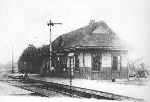 But in its hey-day, the old 'Southern scheduled several trains a day, including passenger trains, and many railroaders layed-over in Westport, taking rooms at the old Owens hotel building across the street from the present bank (1976) and at other rooming houses in town, including the Low Hotel which burned in 1911.
But in its hey-day, the old 'Southern scheduled several trains a day, including passenger trains, and many railroaders layed-over in Westport, taking rooms at the old Owens hotel building across the street from the present bank (1976) and at other rooming houses in town, including the Low Hotel which burned in 1911.
Many present-day citizens (1976) can remember the long strings of coal and coke cars brought in by the New York Central and left on the old "Y' to be picked up by the Southern; they can also remember the many cars of Bedford stone brought in by the Southern to be picked up by the New York Central.

But Westport's fame as the terminus of America's ''most transcontinental railroad" has been relegated to history.
Editor's Note: When the Milwaukee Road acquired the SI, Westport became the furthest point East of any West Coast railroad. - rph
QUARRIES
From the time of the earliest settlements, the limestone in the area was used in various ways. It was used for foundations for buildings, fences, fence posts, sidewalks and later on was crushed and used for roads or for agricultural purposes.
There were many quarries along Sandcreek. McGee's quarry was only a stone's throw north of the old Boicourt grist mill at Horseshoe Bend. The quarries which eventually did the most business were located just west of the old wooden bridge over Sandcreek. There were a few different stone companies operating in the same general area, and it was difficult to tell where one ended and the next started.
The Hollensbe quarry was the largest. One quarry was owned by Mel. Sample and Oliver Stout. John C. Cairn worked in the quarry of Stout and Sample for a few years. Oliver Stout was the author of some poems which appear elsewhere in this book.
Clem fle Croes, a native of France, arrived in the United States, December 4, 1872. He was twenty-two years of age, and one of the first skilled stone cutters in the United States. In 1879, Clem De Croes (age twenty-nine) accepted a contract for building a stone basement for Leander Meredith at Sardinia, Indiana. While there, James Conwell proposed the opening of a quarry at Westport.
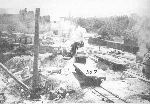 The businessmen of the town, Jack DeArmond, Milt MeWhinney, Isaiah Proctor, and Dr. William M. McCullough agreed to help in giving credit to workers for food, clothing, and necessities until sufficient capital could be accumulated to pay cash wages. The site of the quarry was located by Aaron Boicourt and purchased by Daniel Patterson. The quarry was then opened by Clem De Croes, Gad Gleason, and George Arm strong.
The businessmen of the town, Jack DeArmond, Milt MeWhinney, Isaiah Proctor, and Dr. William M. McCullough agreed to help in giving credit to workers for food, clothing, and necessities until sufficient capital could be accumulated to pay cash wages. The site of the quarry was located by Aaron Boicourt and purchased by Daniel Patterson. The quarry was then opened by Clem De Croes, Gad Gleason, and George Arm strong.
When the quarry was first opened, there was no other industry in Westport. Within a few years, business demanded that a railroad be built from the quarry to the main line of the V.G. & R. Railroad.
 On March 14, 1892, the Hollensbe Stone Company purchased a strip of land and connected their company track with the track of the Evansville and Richmond Railroad Company so as to have an outlet for shipment to the southwest. Up this siding old Hulda", a switch engine, pulled the stone cars.
On March 14, 1892, the Hollensbe Stone Company purchased a strip of land and connected their company track with the track of the Evansville and Richmond Railroad Company so as to have an outlet for shipment to the southwest. Up this siding old Hulda", a switch engine, pulled the stone cars.
In 1892, the Armstrong-Dc Croes interests consolidated with Hollensbe, and later was known as the Hollensbe quarry. At one time the Hollensbe quarry employed one hundred men and owned equipment worth thousands of dollars.
Westport Stone won a fine reputation for its excellence and durability. Some of it was used in a government building at Cincinnati, a court house at Evansville, a court house at Indianapolis, a court house at Bryan, Texas the walls of the State House at Indianapolis, and in structures at St. Louis, Chicago, Louisville, Nashville, Tennessee, Bloomington, Indiana, and many other places.
End of Quote
Two miles south is Harper, with a 19 car siding. This siding was used for storage of cars for Westport and was removed as business declined. Next was Earl siding and Brewersville. Brewersville was located 7 miles
south of Westport along the valley of Sand Creek. This town like the other towns along the VGR had a mill along the river for grinding grain and a sawmill because there was much timber in the area. It also had the necessary stores to make a town. The railroad had a siding and one or two house or team tracks to handle the timber. The depot like the one at Sandusky was not a train order or block station. Passenger trains #1 and #2 stopped here. Because the siding was on a hill, it was replaced by a siding named Earl halfway between Brewersville and Harper and located on level ground. Earl stayed in service until the end of WW2.
Moving south the last 5.5 miles, we come to Norh Vernon. This was the southern terminal for the VGR. After 1891 the Big Four worked out an agreement for trackage rights over the B&O to Jeffersonville, Indiana. At North Vernon there were two sidings, northward and southward. On the east siding at the south end was a 15 car siding used as a delivery track to the Big Four by the B&O. On the west siding a like 15 car siding used as a team track for loading and unloading cars. An elevator and freight house completed the industries. The depot was a train order
and block station through the years. At the north end of the sidings were signals, remote controlled, from North Vernon depot used to control the traffic.
The VGR operated through 81 years of time although under different names. The following years show the history of the VGR through 5 different ownership. VGR--1881-1891, CWM-Cincinnati-Wabash and Michigan 1891-1892, Big Four (Cleveland, Cincinnati. Chicago and St. Louis) 1892-1930, New York Central 1930-1968 and Penn Central from 1968-1973. The track was abandoned North Vernon- to Rushville in 1973.
1968-69
These were taken at Westport in 1968-69. The engine is number 11, an 0-4-0 saddle tanker. The second shot was taken a short way from Westport where they were working on the engine. The gentleman in the last photo is my father, Robert Hensley (deceased). This was a museum operation on the old Big Four line.
The VGR, as with most railroads of the time, started as a glimmer and through merger became a bright light that shined brightly. As society changed, automobiles, trucks, airplanes and sometimes the products they hauled disappeared, time ran out. The VGR, Big 4 and New York Central have all disappeared, their light put out by progress, the same progress that made them giants in their day.
Maurice Lewman
- Thanks to:
- Roger Hensley, Web Master
- Rick Disbro,Milroy
- Mr. Marlow,Sandusky
- Bob Thompson,Letts Corner
Maurice worked the Michigan Division from 1947-1981. He then worked on the Bee Line from 1981-1992. From 1947 until august 1950, he worked on the section at Shirley and Markleville. In 1950 he started firing on steam and then on through the diesels. Maurice said, "I had the pleasure of working with C. C. Staley and Ron Buser many times."
Photo Credits:
Greensburg Coal Dock - late 40s - Bill Klene Collection.
Milroy Depot - 1915 - Marc Haston Collection.
Lett's Corner Depot - 1912 - Marc Haston Collection.
| 











